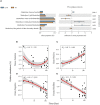Gut Microbiome Succession in Chinese Mitten Crab Eriocheir sinensis During Seawater-Freshwater Migration
- PMID: 35432227
- PMCID: PMC9005979
- DOI: 10.3389/fmicb.2022.858508
Gut Microbiome Succession in Chinese Mitten Crab Eriocheir sinensis During Seawater-Freshwater Migration
Abstract
Biological migration is usually associated with disturbances and environmental changes that are key drivers in determining the diversity, community compositions, and function of gut microbiome. However, little is known about how gut microbiome is affected by disturbance such as salinity changes during migration from seawater to freshwater. Here, we tracked the gut microbiome succession of Chinese mitten crabs (Eriocheir sinensis) during their migrations from seawater to freshwater and afterward using 16S rDNA sequencing for 127 days, and explored the temporal patterns in microbial diversity and the underlying environmental factors. The species richness of gut microbiome showed a hump-shaped trend over time during seawater-freshwater migration. The community dissimilarities of gut microbiome increased significantly with day change. The turnover rate of gut microbiome community was higher during seawater-freshwater transition (1-5 days) than that in later freshwater conditions. Salinity was the major factor leading to the alpha diversity and community dissimilarity of gut microbiome during seawater-freshwater transition, while the host selection showed dominant effects during freshwater stage. The transitivity, connectivity, and average clustering coefficient of gut microbial co-occurrence networks showed decreased trends, while modularity increased during seawater-freshwater migration. For metabolic pathways, "Amino Acid Metabolism" and "Lipid Metabolism" were higher during seawater-freshwater transition than in freshwater. This study advances our mechanistic understanding of the assembly and succession of gut microbiota, which provides new insights into the gut ecology of other aquatic animals.
Keywords: Chinese mitten crab; gut microbiome succession during migration gut microbiome; migration; salinity; seawater–freshwater transition.
Copyright © 2022 Shao, Zhao, Li, Li, Zhang, Li, Xu, Wang and Gao.
Conflict of interest statement
The authors declare that the research was conducted in the absence of any commercial or financial relationships that could be construed as a potential conflict of interest.
Figures






Similar articles
-
Early Succession of Community Structures and Biotic Interactions of Gut Microbes in Eriocheir sinensis Megalopa after Desalination.Microorganisms. 2024 Mar 11;12(3):560. doi: 10.3390/microorganisms12030560. Microorganisms. 2024. PMID: 38543611 Free PMC article.
-
Comparison of the gut microbiota and untargeted gut tissue metabolome of Chinese mitten crabs (Eriocheir sinensis) with different shell colors.Front Microbiol. 2023 Jul 13;14:1218152. doi: 10.3389/fmicb.2023.1218152. eCollection 2023. Front Microbiol. 2023. PMID: 37520354 Free PMC article.
-
Plant and Animal-Type Feedstuff Shape the Gut Microbiota and Metabolic Processes of the Chinese Mitten Crab Eriocheir sinensis.Front Vet Sci. 2021 Jan 26;8:589624. doi: 10.3389/fvets.2021.589624. eCollection 2021. Front Vet Sci. 2021. PMID: 33575282 Free PMC article.
-
Relationship Between the Fatty Acid Profiles and Gut Bacterial Communities of the Chinese Mitten Crab (Eriocheir sinensis) From Ecologically Different Habitats.Front Microbiol. 2020 Oct 15;11:565267. doi: 10.3389/fmicb.2020.565267. eCollection 2020. Front Microbiol. 2020. PMID: 33178151 Free PMC article.
-
Status and prospects of product processing and sustainable utilization of Chinese mitten crab (Eriocheir sinensis).Heliyon. 2024 Jun 13;10(12):e32922. doi: 10.1016/j.heliyon.2024.e32922. eCollection 2024 Jun 30. Heliyon. 2024. PMID: 38994063 Free PMC article. Review.
Cited by
-
Early Succession of Community Structures and Biotic Interactions of Gut Microbes in Eriocheir sinensis Megalopa after Desalination.Microorganisms. 2024 Mar 11;12(3):560. doi: 10.3390/microorganisms12030560. Microorganisms. 2024. PMID: 38543611 Free PMC article.
-
Seasonal dynamics of intestinal microbiota in juvenile Chinese mitten crab (Eriocheir sinensis) in the Yangtze Estuary.Front Cell Infect Microbiol. 2024 Jul 4;14:1436547. doi: 10.3389/fcimb.2024.1436547. eCollection 2024. Front Cell Infect Microbiol. 2024. PMID: 39027136 Free PMC article.
-
Changes in Hemolymph Microbiota of Chinese Mitten Crab (Eriocheir sinensis) in Response to Aeromonas hydrophila or Staphylococcus aureus Infection.Animals (Basel). 2023 Sep 29;13(19):3058. doi: 10.3390/ani13193058. Animals (Basel). 2023. PMID: 37835665 Free PMC article.
-
Bridging Ecology and Microbiomes: Applying Ecological Theories in Host-associated Microbial Ecosystems.Curr Clin Microbiol Rep. 2025;12(1):9. doi: 10.1007/s40588-025-00246-z. Epub 2025 Apr 15. Curr Clin Microbiol Rep. 2025. PMID: 40248762 Free PMC article. Review.
-
Comparison of the gut microbiota and untargeted gut tissue metabolome of Chinese mitten crabs (Eriocheir sinensis) with different shell colors.Front Microbiol. 2023 Jul 13;14:1218152. doi: 10.3389/fmicb.2023.1218152. eCollection 2023. Front Microbiol. 2023. PMID: 37520354 Free PMC article.
References
-
- Anger K. (1991). Effects of temperature and salinity on the larval development of the Chinese mitten crab Eriocheir sinensis (Decapoda: Grapsidae). Mar. Ecol. Prog. Ser. 72 103–110. 10.3354/meps072103 - DOI
LinkOut - more resources
Full Text Sources

